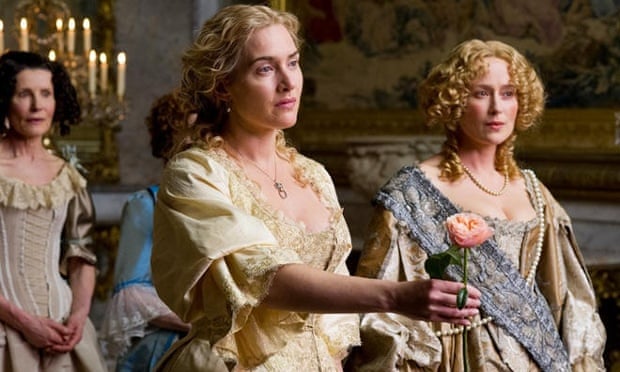
As you’re already totally aware, this month brings with it National Gardening Week: seven glorious days for us all to discuss hanging baskets without fear of social rejection. The annual holiday was launched four years ago to celebrate the splendour of grass, flowers and trowels. But this year’s festivities will be marked by something extra special. The new, garden-featuring period drama A Little Chaos has been announced as National Gardening Week’s official film which means that, well, a microsite has been launched with a competition to win tickets to a flower show. And yes, that’s about it.
The film, which stars Kate Winslet as a competitive landscape designer who falls for her boss, has had mixed reviews, but the decision to work with the Royal Horticultural Society at least plays into their key demographic: people who like gardens. Unsurprisingly, it’s the first time there has been an official film for the week-long soil celebration.
Winslet is no stranger to partnering with dubious national celebrations: her melodrama Labor Day was a key element of last year’s National Pie Day. The cross-promotion hinged on a pivotal scene where convicted killer/helpful man-about-the-house Josh Brolin teaches Winslet how to make peach pie, and (naturally) awakens her sexuality. A poster was sent out to bakeries and a Facebook competition launched for pie-lovers to enjoy a private screening.
But the film failed to bring in an audience, even of pie-eaters, with a worldwide gross of only $20m – and the decision to focus a marketing campaign on a scene that was the movie’s unintentionally hilarious low point was, said Lou Lumenick of the New York Post, an “eccentric choice”.
Disney’s recent hit Big Hero 6 happened to coincide with National Hugging Day, which meant that its creator Kevin Zaborney, AKA the Ambassador of Hugs, awarded inflatable robot Baymax the accolade of most huggable character of 2015. Previous winners have included no one – the honour was cooked up to promote the film. But, while the association might seem spurious, the specially created trailer generated 1m views.
While the national holiday tie-ins seem to include the bare minimum of activity, other partnerships work harder to offer more effective, and shareable, content. One of the most successful examples recently saw Air New Zealand join forces with Warner Bros on Hobbit-themed in-flight safety videos. Statistics show that 14% of all visitors to New Zealand are influenced by what they see at the movies, which this campaign cleverly played on. It was a hit online with more than 30m views across the three ads, and visitor figures were up 6.2% last year.
Linking an airline or tourist board to a film’s promotional campaign is a clearer choice of partner than many other case studies. After watching Skyfall, for example, it seems only natural that some audiences might want to visit its locations, so teaming up with Visit Britain makes total sense: there was a reported rise of 41.7% in visits to Glencoe, Scotland after the film’s release. But action-seekers hoping to get involved in a shootout might have been somewhat shortchanged with the spy-free scenery and locals have been fighting back against an increase in litter from disappointed 007 fans. Equally, the Yemen tourist board were forced to sadden fans of Ewan McGregor comedy Salmon Fishing in the Yemen about the lack of actual salmon fishing in the country after they were inundated with eager travellers who clearly thought the film was a documentary.
Finding the right partner for a campaign is key and it’s these carefully considered collaborations that can make a difference. Last year’s partnership between X-Men: Days of Future Past and Virgin Trains seemed like a match made by randomly picking companies out of a hat. The April Fool’s hilarity of rebranding Wolverhampton station as Wolverine and a specially refurbished train with the characters plastered all over it didn’t feel like a natural fit for the film which didn’t a) take place in England or b) feature any trains. Eurostar jumping aboard as the official travel partner of 2004’s Paris-set Phantom of the Opera was a better fit. But since when was having “official travel partner” the key to a film’s marketing campaign?
Some promotional collaborations also have another more earnest objective in mind. With the release of every Saw film, a “Give Til’ It Hurts” blood drive took place and by the time Saw IV was out, the American Red Cross became an official partner. The event was always promoted with an artfully gruesome poster and horror fans were encouraged to give blood, leading to more than 40,000 gallons being donated. In a similar, ahem, vein, last year’s Hunger Games entry saw Lionsgate working with Whole Food Market in a charitable effort that saw money donated to a global poverty charity for every branded bottle of juice.
But donating blood and money wasn’t enough for one particularly demanding campaign ...
In 2013, Zack Snyder’s city-crushing spectacle Man of Steel boasted more than 100 official brand partners. The most insidious was a deal with the National Guard, which involved a campaign to recruit “soldiers of steel” by tying the mythology of Superman to the work of the military. Snyder himself worked on specially branded ads, and there was a tie-in workout routine and online game. The objective was recruitment (would you like to destroy stuff just like Superman?) and the key demographic of 17- 24-year-olds mirrored the target audience for the superhero blockbuster.
While increased ticket sales and interest in the brand are obvious aims for these sorts of activity, often it’s as simple as getting a journalist to write about it. Before you started reading this article, were you even aware of Kate Winslet’s new film about gardening? Had you even realised that National Gardening Week was a thing? Are you craving peach pie now? Do you want a hug? Shall we all go to Glencoe together? And then join the army? Maybe we’re part of the problem.